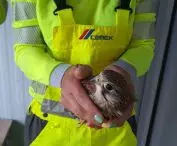40 kestrels to leave CEMEX cement plants in 2021
Concernfor the environment and biodiversity is an important part of CEMEX Poland 's strategy. That's why the company is running a project to support the population of this protected species at its cement plants in Chelm and Rudniki, where the kestrel has been found. After the 2021 season, CEMEX is sharing the results of the work under the guidance of experienced ornithologists.
The kestrel(Falco tinnunculus), is a small falcon under strict species protection in Poland, and according to the current Regulation of the Minister of the Environment, it additionally requires active protection, i.e. human assistance. Concern over the declining numbers of Falco tinnunculus in Poland is also confirmed by ornithologists-enthusiasts from the Gdansk-based Association for Kestrels and Swifts, who, at the invitation of CEMEX Poland, conducted kestrel surveys at the company's facilities this year.
One of the most significant reasons for the kestrel's decline is the lack of suitable nesting sites. To help the population of this species, CEMEX Poland has installed special nesting boxes at its cement plants in Chelm and Rudniki. These artificial nesting sites not only enable the birds to lay their eggs every year, but also ensure their safety thanks to their design.
- The kestrel protection project, which has been conducted by CEMEX Poland for 10 years, has contributed to the hatching of an estimated 200 young birds. - says Monika Wosik, Director of Environmental Protection and Sustainable Development at CEMEX Poland. - This year they were joined by 40 more individuals, 25 in Chelm and 15 in Rudniki, she adds.
As part of its 2021 project to study the ecology of the kestrel, CEMEX decided to ring eleven chicks, as well as to put a GPS transmitter on one of the birds, which allows more data to be acquired than traditional ornithological rings. The kestrel with ring code 13Y, which was named Aurora as part of a competition conducted by CEMEX, was monitored for more than two months using a special app. During this time she covered as much as one and a half thousand kilometers. The length of the route for an approximately three-month-old bird seems impressive. Aurora left Chelm at the end of June to migrate through the Mazovia and Podlasie provinces to Belarus, from where she decided to return to the Lublin region. Unfortunately, she did not make it back to the cement plant where she was born, because, like most young representatives of the species, she died. The survival rate of kestrels in their first year of life is estimated at only 20-50%. These highly disturbing data confirm the importance of any action taken to protect this species.
The 2021 season was a very successful one, both in terms of the number of birds that were born at CEMEX facilities and the range of data we were able to obtain about them. The kestrels have now left the nesting boxes at the cement plants and will not return until March. However, the company is already preparing for the next year, during which it plans further activities within the framework of the ongoing project.
For more information, visit the company 'sCEMEX Polska Sp. z o.o. page on theAiB portal.
















